Agamben and the
Signature of Astrology
Agamben and the
Signature of Astrology
Spheres of Potentiality
Paul Colilli
LEXINGTON BOOKS
Lanham Boulder New York London
Published by Lexington Books
An imprint of The Rowman & Littlefield Publishing Group, Inc.
4501 Forbes Boulevard, Suite 200, Lanham, Maryland 20706
www.rowman.com
Unit A, Whitacre Mews, 26-34 Stannary Street, London SE11 4AB
Copyright 2015 by Lexington Books
All rights reserved. No part of this book may be reproduced in any form or by any electronic or mechanical means, including information storage and retrieval systems, without written permission from the publisher, except by a reviewer who may quote passages in a review.
British Library Cataloguing in Publication Information Available
Library of Congress Cataloging-in-Publication Data
Colilli, Paul, 1952
Agamben and the signature of astrology : spheres of potentiality / Paul Colilli.
p. cm.
Includes bibliographical references and index.
ISBN 978-1-4985-0595-6 (cloth : alk. paper) -- ISBN 978-1-4985-0596-3 (ebook)
1. Agamben, Giorgio, 1942- 2. Astrology. I. Title.
B3611.A44C65 2015
195--dc23
2015027563
 TM The paper used in this publication meets the minimum requirements of American National Standard for Information Sciences Permanence of Paper for Printed Library Materials, ANSI/NISO Z39.48-1992.
TM The paper used in this publication meets the minimum requirements of American National Standard for Information Sciences Permanence of Paper for Printed Library Materials, ANSI/NISO Z39.48-1992.
Printed in the United States of America
List of Figures
Acknowledgments
This book is the result of an extended inquiry that coalesced during my sabbatical from Laurentian University in 20132014. The initial findings of my research were presented in public lectures I gave at the University of North Carolina, Chapel Hill; the University of Toronto; and the University of California, Berkeley. Thus, many thanks to Katie Boyle, Domenico Pietropaolo, Salvatore Bancheri, and Alani Hicks-Bartlett, for having invited me to discuss my work at their respective institutions. Some of the early results of the work discussed in this book, which have since been reconceptualized and recast, appeared in The Astrological Signs Left to Posterity, Annali ditalianistica, Vol. 23, 2005: 12132; The Theological Materials of Modernity (On Giorgio Agamben), Italica, n. 3, 2008: 46680; and Dell
astrologia razionale (scholia in margine a Laperto di Giorgio Agamben), in Esperienze letterarie, no. 2, XXXVI, 2011: 2337.
I would also like to thank my students past and present at Laurentian University, and my former students when I was visiting professor in the Scuola Italiana of the Middlebury College Language Schools for the inspiration they provided me. Thanks as well to Julian Colilli for his editorial assistance. Finally, at Lexington Books/Rowman and Littlefield I would like to express my gratitude to Lindsey Porambo (associate editor) and Marilyn Ehm (assistant editor) for their invaluable assistance and support for my book project. Illustrations from the Ambrosiana Jewish Bible, copyright by Veneranda Biblioteca Ambrosiana, Milano/DeAgostini Picture Library. Excerpts from Duino Elegies by Rainer Maria Rilke, translated by David Young, copyright 1978 by W.W. Norton & Company, Inc. and used by permission of W. W. Norton & Company, Inc. Unless otherwise indicated, all translations are my own.
Introduction
A significant quantity of literature continues to amass around the name of Giorgio Agamben. This is due, in the greatest part, to the sheer volume of his output as well as to the originality and the controversial nature of his thought. Agamben is a thinker who, to paraphrase an expression he frequently uses when commenting on his preferred writers, produces work that has potential for further elaboration. This book deals with one aspect of the possibilities present in Agambens oeuvre but whose potentialities remain unwritten; namely, the matter of astrology. Precisely because it was perceived as being purely irrational and no longer intelligible, astrology was banished from the tradition of modern thought. As we will illustrate throughout the pages of this study, Agambens work has activated the possibility of making the present a time for the legibility of astrology.
As the ancient science that sought to prognosticate about the unfolding of human and life and history on the basis of the motion and configurations of celestial bodies, astrology has undergone a series of deaths and resurrections. It flourished during the time of the ancient Greeks and the age of Late Antiquity, but then disappeared with the advent of Christianity. Astrology re-emerged in the Medieval period, which lead it to then achieve a profile of historical importance during the Renaissance, but this was followed by a radical marginalization at the hands of classical rationalism and experimental science. In a subsequent historical phase, the nineteenth century witnessed a philological rediscovery of astrologys significance to Western culture. Yet, in the Modern age astrology remains an historical curio that fails to be perceived as a useful and credible paradigm for understanding the world. In 1975 a group of noted scientists and philosophers, including Nobel Prize winners, published an attack against astrology, whose popularity was on the rise at the time, for not having a scientific foundation. In this way it is oblivious to the fuller spectrum of human existence and thus could not capture the subtleties and depths of ontology, of being-in-the-world. It would follow, then, that the astrological practices that have been bequeathed to us are incapable of seriously addressing the questions of human life and history.
Given all of this we ask: does astrology offer possibilities to uncover dimensions of human life that are alternative models to theology, philosophy, and politics, or which explore epistemological data that the other disciplines are not able to articulate or intentionally ignore? At stake in such a quaestio is the unthought notion that astrology is an instrument that sheds light on existence, which it was, instead, believed to have obscured, falsified, and rendered unintelligible. The works of Agamben are the context for visualizing the potentialities of astrology as they emerge from a crypt in the topography of contemporary thought in which they are imprisoned.
The point of departure for interrogating the connection between Agamben and astrology is the figure of Aby Warburg. In an interview from 2006, Agamben mentions a potential area of research dealing with the monumental project that Warburg was working on before he passed away in 1929. I returned to Warburg, Agamben confesses in the interview, after many years: I needed to, I think, after this turn to the problems of political philosophy.... The work I have been doing most recently deals precisely with... [what] Warburg... called Mnemosyne. Warburg had begun the Mnemosyne project in December 1927; it was to be a work in the form of a picture atlas, consisting of forty panels and approximately one thousand images taken from a variety of different historical periods. The atlas had no captions but there were some texts, although Warburg had planned to write a commentary to accompany it; however, it was left unfinished when he died in 1929. Agamben had spent the autumn of 1974 working at the Warburg Institute in London, and his interest in Warburgs method is evident in
Next page
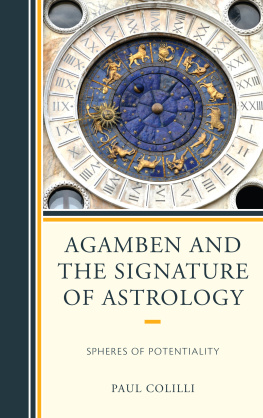
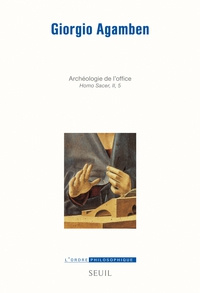

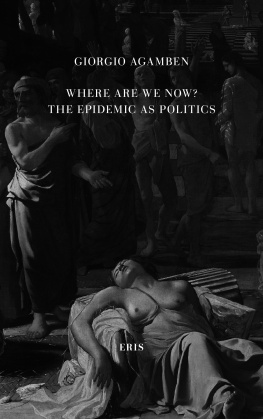
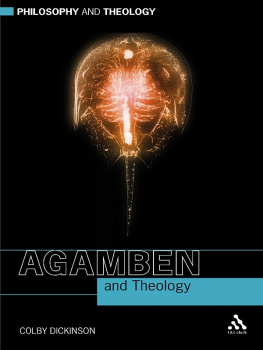




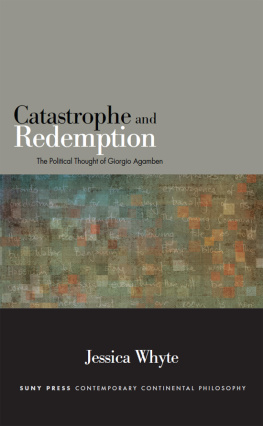
 TM The paper used in this publication meets the minimum requirements of American National Standard for Information Sciences Permanence of Paper for Printed Library Materials, ANSI/NISO Z39.48-1992.
TM The paper used in this publication meets the minimum requirements of American National Standard for Information Sciences Permanence of Paper for Printed Library Materials, ANSI/NISO Z39.48-1992.